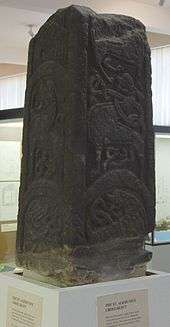Alchmund of Derby
| Saint Alcmund. | |
|---|---|
|
Image of St Alcmund | |
| Died | 800 AD |
| Venerated in | Roman Catholic Church |
| Feast | March 19 |

Alcmund of Derby or of Lilleshall, also spelt Ealhmund, Alhmund, Alkmund, or Alchmund (d. c. 800) was son of Alhred of Northumbria. After more than twenty years in exile among the Picts as a result of Northumbrian dynastic struggles, he returned with an army. He was killed in about 800, for which King Eardwulf of Northumbria was held responsible. Whatever the exact circumstances, his death was regarded as a martyrdom, and Alcmund as a saint.[1]

Alcmund was buried at Lilleshall in Shropshire, where miracles were reported at the tomb. Due to Danish raids, his body was translated to Derby. St Alkmund's Church, Derby and the nearby St Alkmund's Church, Duffield in Derbyshire were dedicated to him. When the Derby church was demolished in the 20th century, several earlier churches were revealed, stretching back to the 9th century. Artefacts found included the stone sarcophagus.[3] In the early tenth century, his remains were translated to Shrewsbury, probably by Æthelflæd, Lady of the Mercians.[4]
His feast day is 19 March.
Gallery
See also
References
- ↑ Signage at Derby Museum notes that he was recorded in the 9th century as being a Saint buried in the Minster beside the Derwent at a place called Northworthy - whose Viking name is Derby.
- ↑ The museum's exhibit label says "Part of 9th-century Anglo Saxon stone cross which once stood at St. Alkmund's church, Derby. This stone was found when St Alkmund's church was rebuilt in 1844. The cross was originally about 4 metres tall. There are birds and beasts carved on all four sides."
- ↑ Sarah Allard, Nicola Rippon (2003). Goodey's Derby (Paintings and Drawing in the Collection of Derby Museum & Art Gallery) p.134. Breedon Books Publishing Co Ltd. ISBN 978-1-85983-379-7.
- ↑ Meijns, Brigitte (2010). "The Policy on Relic Translations of Baldwin II of Flanders (879–918), Edward of Wessex (899–924), and Æthelflæd of Mercia (d.924): A Key to Anglo-Flemish Relations". In Rollason, David; Leyser, Conrad; Williams, Hannah. England and the Continent in the Tenth Century. Turnhout, Belgium: Brepols. p. 476. ISBN 9782503532080.
- Grosjean, P., Codicis Gothani Appendix (Vita Sancti Aelkmundi regis), Analecta Bollandiana lviii (1940), 178-83
![]() This article incorporates text from a publication now in the public domain: Herbermann, Charles, ed. (1913). "article name needed". Catholic Encyclopedia. New York: Robert Appleton.
This article incorporates text from a publication now in the public domain: Herbermann, Charles, ed. (1913). "article name needed". Catholic Encyclopedia. New York: Robert Appleton.


